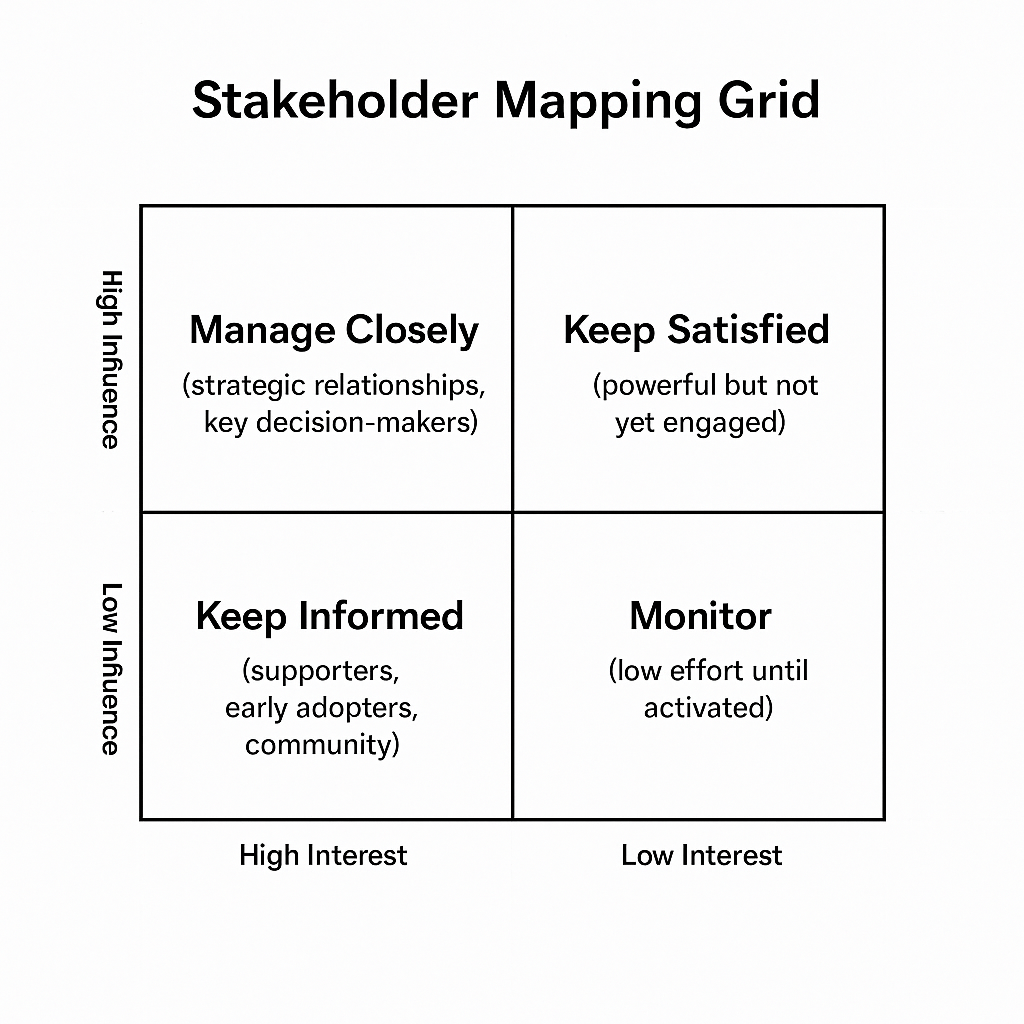Understanding who matters most to your mission, and how to engage with them, is vital for any business, especially in the startup and innovation space. Whether you’re building a cyber risk platform, championing cyber psychology, or coordinating a regional community like the West Midlands Cyber Working Group (WM CWG), the ability to identify, map, and actively engage stakeholders is fundamental to long-term success.
This article is with thanks to Robin Kennedy and Emma Fadlon of Innovate UK, based on my time with the academic leaders on the 2025 CyberASAP cohort. Thank you!
One of the most useful tools for this kind of strategic thinking is the Stakeholder Mapping Grid, also known as the Power-Interest Matrix. I was reminded of its clarity and value thanks to Emma Fadlon, who delivered a brilliant overview of this and other essential tools during CyberASAP’s startup familiarisation days (Days 1–3). This article shows how we’ve applied the Stakeholder Mapping Grid across three interlinked initiatives: Cyber Tzar, Psyber Inc., and the West Midlands cyber ecosystem.
1. What is a Stakeholder Mapping Grid?
The Stakeholder Mapping Grid helps founders and teams prioritise outreach, communications, and relationship-building efforts. It does this by categorising stakeholders along two key dimensions:
- Interest – How much a stakeholder cares about or is affected by your mission.
- Influence – How much power a stakeholder has to affect your work or outcomes.
This creates a 2×2 grid:
| High Interest | Low Interest | |
|---|---|---|
| High Influence | Manage Closely | Keep Satisfied |
| Low Influence | Keep Informed | Monitor (Minimal Effort) |
This deceptively simple framework brings clarity and focus, whether you’re looking to secure funding, win customers, recruit allies, or build trust within your region.
2. Example Stakeholders
Here’s a quick illustrative table, based on Emma’s session and expanded with a few of my own examples:
| Stakeholder Category | Description | Example Stakeholders |
|---|---|---|
| High Influence / High Interest | Manage Closely – key partners and decision-makers | – Major customers – Sector partners – Trade bodies – DSIT and regulators |
| High Influence / Low Interest | Keep Satisfied – powerful but not yet engaged | – Police (e.g. national cyber units) – Umbrella associations – NGOs – Investors |
| Low Influence / High Interest | Keep Informed – supporters, early adopters, advocates | – Smaller customers – Academics – Local charities – Cyber meetups |
| Low Influence / Low Interest | Monitor – minimal effort until needed | – General public – Small competitors – Local press |
3. The Generic Stakeholder Mapping Grid
Before diving into specific organisational grids, here’s a typical version populated with familiar stakeholder types:
| High Interest | Low Interest | |
|---|---|---|
| High Influence | Manage Closely (key relationships) – Major customers – Sector partners – Influencers – Regulatory bodies | Keep Satisfied (powerful, not engaged) – Police units – Umbrella associations – NGOs – Investors |
| Low Influence | Keep Informed (supporters) – SMEs – Academics – Meetups – Tech hubs | Monitor (minimal effort) – Public – Small competitors – Peripheral charities |
This version helps any team prioritise where to put their attention and adapt strategies to bandwidth and phase of growth.
4. Cyber Tzar: Stakeholder Grid
Cyber Tzar is a cybersecurity platform focused on Enterprise Supply Chain Risk, Cyber Risk Scoring, and Insurtech Analytics. Our stakeholders range from government funders to early adopters and data-focused partners.
Key Highlights:
- Manage Closely: DSIT, UK Cyber Security Council, Midlands Cyber, major clients.
- Keep Satisfied: Police/NCSC, ABI, local authorities, big consultancies.
- Keep Informed: SMEs, alumni networks, early-stage tech ecosystems, academics.
- Monitor: General public, minor competitors, disconnected press.
This grid continues to shape our communications, partnerships, and funding roadmap.
5. Psyber Inc.: Stakeholder Grid
Psyber Inc. is an early-stage startup at the intersection of cyber psychology, human factors, and digital resilience. Co-founded with Sevgi Aksoy, it brings academic rigour and behavioural insight into commercial cyber practice.
Key Highlights:
- Manage Closely: Aston University, UK Cyber Security Council, DSIT, IAWM.
- Keep Satisfied: Home Office, Police, British Psychological Society, HSE.
- Keep Informed: PhD students, digital ethics forums, outreach groups.
- Monitor: Public, non-digital charities, irrelevant media.
This mapping reflects Psyber’s hybrid model: part research, part commercial, and fully human-centred.
6. Stakeholder Grid: WM CWG & West Midlands Cyber Ecosystem
As chair of the West Midlands Cyber Working Group (WM CWG), I’ve worked with key regional players to re-energise collaboration across the Midlands. Understanding who’s engaged, and who we need to bring in, has been central to our success.
Key Highlights:
- Manage Closely: DSIT, IAWM, WMCRC, universities, Midlands Cyber, UKTL.
- Keep Satisfied: WMCA, local authorities, Police/NCSC, chambers of commerce.
- Keep Informed: Cyber meetups, startups, community groups like CyberWomen@Birmingham.
- Monitor: General public, dormant players, non-digital SMEs.
This grid is helping shape our Cyber Local funding strategy and the upcoming West Midlands Cyber Festival.
7. Wrapping Up: Why Stakeholder Grids Matter
Stakeholder mapping is not a one-time exercise. It’s a living strategy tool that evolves with your project and deepens with your relationships. When used well, it:
- Clarifies who to prioritise
- Avoids wasted energy on low-impact relationships
- Surfaces new alliance opportunities
- Makes bids, projects, and partnerships more credible and aligned
A huge thanks again to Emma Fadlon from UKRI, whose CyberASAP session reminded many of us just how valuable this simple technique remains. It’s not just about boxes on a slide, it’s about building momentum with the right people, in the right way.
